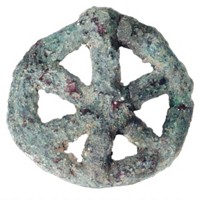Advertisement
Grab your lab coat. Let's get started
Welcome!
Welcome!
Create an account below to get 6 C&EN articles per month, receive newsletters and more - all free.
It seems this is your first time logging in online. Please enter the following information to continue.
As an ACS member you automatically get access to this site. All we need is few more details to create your reading experience.
Not you? Sign in with a different account.
Not you? Sign in with a different account.
ERROR 1
ERROR 1
ERROR 2
ERROR 2
ERROR 2
ERROR 2
ERROR 2
Password and Confirm password must match.
If you have an ACS member number, please enter it here so we can link this account to your membership. (optional)
ERROR 2
ACS values your privacy. By submitting your information, you are gaining access to C&EN and subscribing to our weekly newsletter. We use the information you provide to make your reading experience better, and we will never sell your data to third party members.
Materials
As Light As Air
After a fitful start, aerogel insulation is fulfilling its promise
by Michael McCoy
November 22, 2010
| A version of this story appeared in
Volume 88, Issue 47

In the late 1920s, Samuel Stephens Kistler invented an incredibly light and durable silica he called aerogel. It’s taken a good 80 years, but aerogel finally seems to be realizing its commercial potential.
One sign was last month’s announcement that BASF, the world’s largest chemical maker, led a $21.5 million investment in Aspen Aerogels—one of only two companies to manufacture aerogel commercially. Two weeks later, Cabot Corp., the other producer, announced that aerogel sales in its recent fiscal year rose a heady 60% to $24 million.
These achievements and others like them in the past couple of years mark a coming out of sorts for a material that had long failed to live up to its potential. “For many years, aerogel was considered a laboratory curiosity that was really neat but not very useful,” acknowledges Tom Miller, the strategic partnerships manager at Cabot Aerogel.
Aerogel was discovered when Kistler, a chemistry professor at the College of the Pacific, in Stockton, Calif., removed the liquid from a silica gel via supercritical drying. The result was a fine, porous structural skeleton sometimes called frozen smoke for its light weight and eerie translucent look. To this day it’s considered the lightest and best-insulating solid in the world.
But Kistler’s manufacturing process was dangerous and expensive. Despite intensive research over the years by Monsanto, BASF, and several other leading chemical companies, commercialization remained elusive. Aerogel seemed doomed to obscurity.
Things changed in the 1990s when researchers at the University of New Mexico came up with a surface modification technique that allowed for subcritical liquid evaporation without significant gel shrinkage. Companies including Cabot, Dow Corning, and Hoechst all launched surface modification research programs.
In the late 1990s, Boston-based Cabot cornered the intellectual property around this technique by purchasing or licensing patents from Dow Corning and Hoechst. In 2003, the company opened a commercial-scale plant in Frankfurt, Germany, that manufactures its Nanogel brand aerogel.
Elsewhere in Massachusetts, meanwhile, another approach to making aerogel was emerging. In 2001, Aspen Aerogel was formed as a spin-off from a contract R&D firm. Scientists there had developed a way of casting silica gel onto a fibrous batting and then supercritically drying the resulting blanket.
Aspen spent several years perfecting the process in a small facility at its Northborough, Mass., headquarters. In 2008, it opened a $30 million plant in East Providence, R.I., that tripled its capacity.
Today, the fruits of the two companies’ research, development, and production efforts are emerging. Harry Walkoff, Aspen’s vice president of sales and marketing, says he’s seen aerogel come into its own in the four years he’s been with the firm.
The East Providence plant was actually completed in 2006, he says, but it didn’t open for another year because of a lack of demand. Soon after the plant started up, though, the product began to gain traction.
“We turned it on in 2008 and pretty quickly filled it up,” Walkoff recalls. Over the past two years, Aspen has expanded the facility by 20%. It’s in the process of building a second line that will double capacity by next March. And the firm is studying the possibility of a third line in East Providence as well as an entirely new facility, Walkoff says.
For Aspen, the turning point in aerogel development was defining a market focus. Although many intriguing markets beckoned, executives determined their best bet was on insulation applications in the oil, gas, and chemical industries.
Some of the firm’s first commercial contracts were to supply aerogel insulation for subsea oil transmission pipelines that go deep into the ocean. By holding the oil at a steady temperature as it travels through the pipe, the aerogel prevents unwanted waxes and hydrates from condensing. Other insulating materials can be used, Walkoff says, but at such a thickness that bigger, more expensive carrier pipes are needed to accommodate them.
At Cabot, Miller doesn’t identify a single turning point but rather a series of milestones that have marked aerogel development. A big one, of course, was construction of the Frankfurt plant. More subtle, he says, was critical work by Cabot and Aspen to develop products beyond the monolithic blocks that characterized the first aerogels.
Cabot also has enjoyed success in the deep-sea market, Miller says. And because Cabot’s manufacturing process yields a translucent granular material, the company sells aerogel as an insulator for roofs that let in daylight. For example, the roofing system company Birdair recently installed a sports-center roof in Calgary, Alberta, made of Nanogel sandwiched between two layers of polytetrafluoroethylene film.
Cabot and Aspen are homing in on other construction markets, both on their own and with partners. BASF already uses Aspen insulation products at its chemical plant in Antwerp, Belgium, Walkoff says. The German firm’s recent investment in Aspen is part of its plan to develop an aerogel-based wall system for energy-efficient homes and buildings.
In September, Cabot and the Danish firm Rockwool International introduced a construction board that combines aerogel with mineral wool, a fibrous building material based on volcanic rock. The partners call the new material a “breakthrough” for building insulation applications where space is at a premium.
James Meier, owner of JTM Consulting, has been in the insulation business for 20 years, four of them with Aspen. Although the insulation industry is conservative, Meier says he’s seen attitudes toward aerogel change in recent years.
“The credibility of the product is rising. People are thinking about it now,” he says. “It’s becoming a product of choice in the tool chest of engineers.”
In his own consulting business, Meier often includes aerogel among the insulation options he offers. Still, it’s more expensive than fiberglass, he notes, and is not often adopted in residential or commercial construction in the absence of incentives or special circumstances.
Although he’s an insulation specialist, Meier is fascinated by aerogel’s broader potential. Indeed, the material’s unique properties invite consideration for all manner of applications. For example, Walkoff says Aspen and partners have developed insulating materials for apparel, appliance, and transportation uses. In 2006, two climbers ascended Mount Everest with sleeping mats and boot inserts made of Aspen aerogel blankets.
Cabot’s Miller is casting an even wider net. After oil and gas and construction, his company is targeting specialty chemical applications as a third major market for aerogel. “Cabot sees itself as a performance materials company rather than an insulation company,” Miller points out.
He says aerogel is attracting interest as a matting agent in ultraviolet-cured finishes, as a rheology control additive, and as a reinforcing agent. Miller is particularly bullish on adding aerogel to industrial coatings, both for saving energy and for protecting workers from hot pipes, vessels, and tanks.
For Miller, part of the fun of the job is seeing new uses emerge from unlikely quarters. “We get a lot of interest from all over the world in all kinds of application areas. I don’t know where the next big market for aerogel will come from,” he says. “I do know we have plenty of work just with the ones on our plate now.”





Join the conversation
Contact the reporter
Submit a Letter to the Editor for publication
Engage with us on Twitter